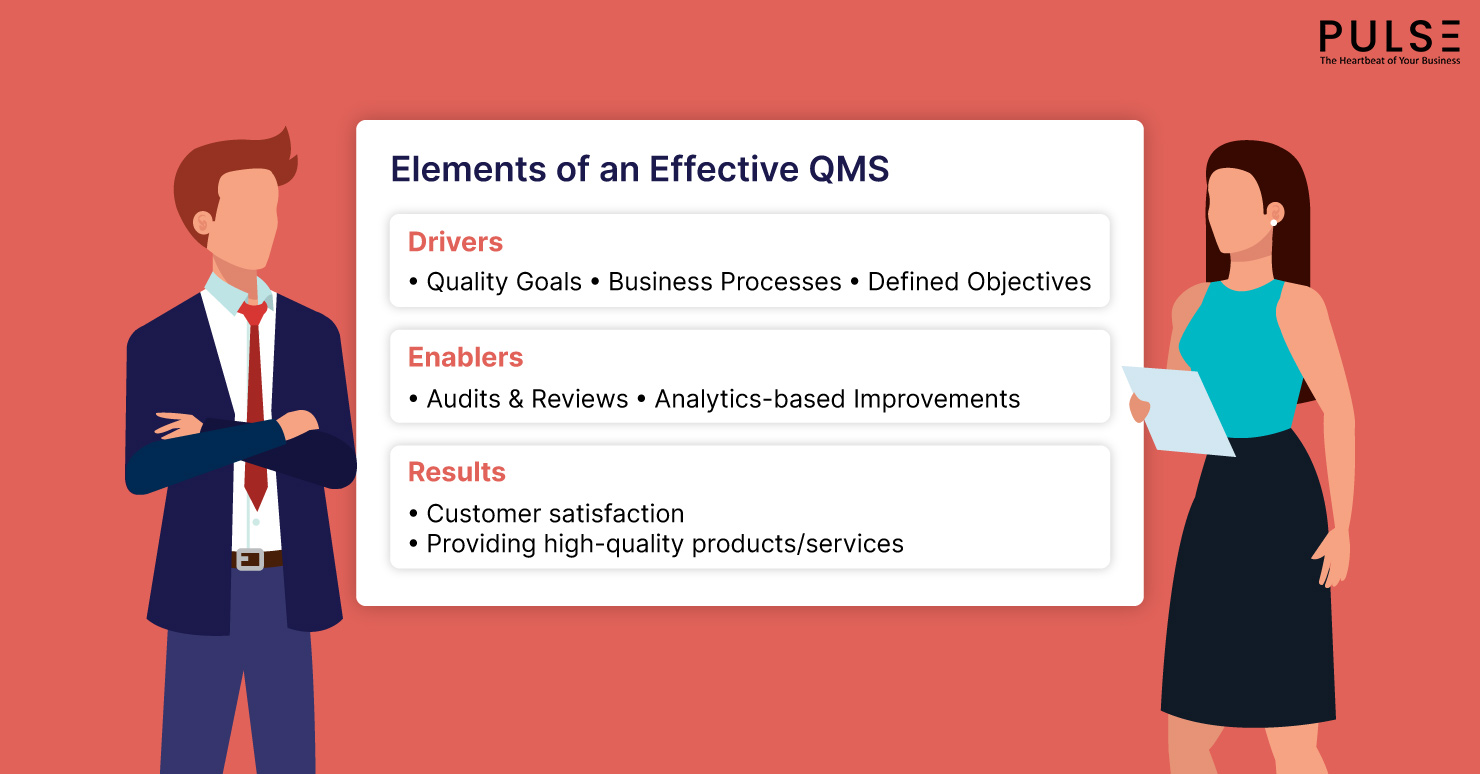Most businesses consist of multiple complex processes and steps necessary for the company to function efficiently. With so many tedious tasks, maintaining uniformity and quality amongst them all can often be quite tricky. It is here that incorporating one of the various types of quality management systems can be highly beneficial.
What Is a Quality Management System?
A Quality Management System (QMS) is a documented system that defines the policies, procedures, processes, functions, etc., that a business should follow to maintain efficient functioning. These systems cover various details, ranging from the steps followed for production functions to contacting clients.
QMS’s are designed to improve the efficiency of a company by creating clear guidelines on how to provide high-quality products/services with minimal wastage and maximum customer satisfaction.
However, as these systems are often quite complex, there are no ‘perfect’ QMS for all organizations. Thus, there are various quality management systems, and they usually consist of multiple elements.
Let’s understand some of the features that make up a QMS.
Also Read: What Is a Quality Management System and Why Is it So Important?
Elements Of an Effective Quality Management System
Based on the functions of a QMS, it needs to have a variety of components that can make managing tasks much more accessible. As a QMS is focused on increasing the efficiency of a firm, having elements consisting of a goal, company mission, clear guidelines, post-work measures, and more will help create a comprehensive system.
In a more defined sense, the elements can be divided into three sections which are Drivers, Enablers, and Results:
Drivers
Drivers consist of the factors that create a business’s basic functions and are essential for it to function. Some of the primary drivers in a company are:
- Quality Goals
- Business Processes
- Defined Objectives
Enablers
Following Drivers, Enablers are the factors that allow the essential functions to work towards results and improve accordingly. For example:
- Audits & Reviews
- Analytics-based Improvements
Results
The final and most essential stage of most types of Quality Management Systems is the Results. These are the goals a firm wishes to achieve from their functioning and often consist of a common goal. This is:
- Customer satisfaction
- Providing high-quality products/services
Similarly, a Quality Management System consists of a Quality Manual, which defines how a company should complete all the above processes and elements. Some factors that are essential for a Quality Manual are:
- Processes with detailed explanations
- Raw materials and resources required
- Final product/service that is to be produced/delivered
- Method to incorporate changes and improvements
- Guidelines for audits to gauge errors and processes
- Basic policy for ensuring quality
- Analytics for operations and how they can be utilized to assess functions
What are The Different Types Of Quality Management Systems?

Due to the differences in various kinds of business and their goals, there are also multiple types of Quality Management Systems designed for them. Therefore, when deciding on a QMS or building one for your firm, you must use the right quality management system to ensure that the standards and rules apply to your business.
One of the most commonly used QMS is the ISO 9001. This is a set of QMS standards that a company can utilize to create its customized management system tailored to its specific business.
The ISO 9001 is focused on improving communications across all stages steps of a business from start to finish to assure maximum customer satisfaction.
Apart from the ISO 9001, there are various other types of quality management systems focused on specific types of businesses and processes. Some prominent examples are:
- ISO 14001 – These standards are designed to be used in an environmental management system(EMS).
- ISO 45001 – The ISO 45001 consists of policies, processes, guidelines, and rules for health and safety in a health and safety management system.
- ISO 50001 – This is an International Standard focused on providing organizations with a framework for improving energy use and consumption.
- ISO 22000 – ISO 22000 – One of the more recently published guidelines first launched in 2018. It is now followed internationally and sets requirements for food safety management systems(FSMS).
With all these types of quality management systems, how exactly can they help the functioning of a firm? Let’s find out.
Also Read: How Robust Quality Management System Lead to Company Success
Advantages Of Using A Quality Management System?
There are many advantages to incorporating an effective Quality Management System into any business. Some of which are:
- Sets clear instructions for training
- Makes auditing much more streamlined
- Reduces the possibility for mistakes
- Improves uniformity in processes
- Makes it easier to gauge growth through analytics
Incorporating a quality management system(QMS) into any business can help improve work efficiency and lead to overall uniformity and growth. That being said, there are many types of quality management systems, and each of them consists of various elements essential for effective functioning.
Most primarily, having clearly defined Drivers, Enablers, and Results is essential to ensure that any QMS is focused on customer satisfaction and sets defined and focused guidelines.To make this complex procedure less tedious, we at Pulse can help you out. Using our cutting-edge AI inspection and auditing tool, you can easily manage and analyze your QMS to ensure compliance with standards. In addition, Pulse can also help you ensure that it efficiently achieves customer satisfaction, employee safety, and more. Just click here to book a demo or contact us via email, and we can help you build an effective QMS!
